
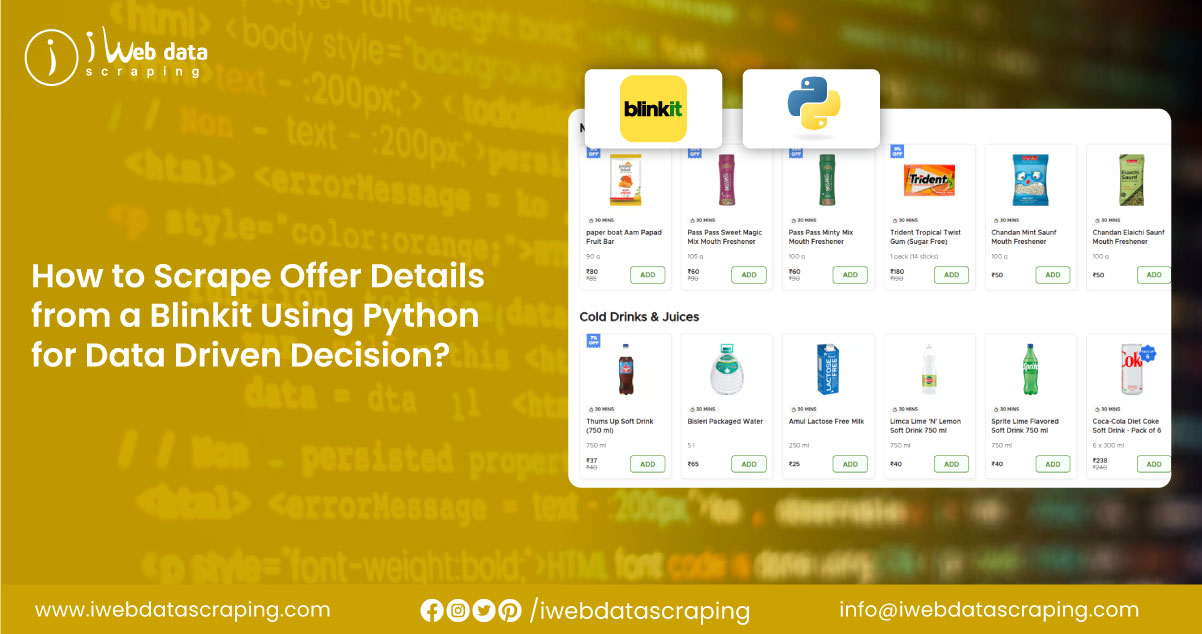
In today's fast-paced world, e-commerce platforms like Blinkit (formerly Grofers) have gained immense popularity due to their quick delivery of groceries and other daily essentials. With an increasing demand for data-driven insights, businesses and developers are turning to Grocery data scraping services to collect data, including offer details, product prices, and more. Python, with its extensive ecosystem of libraries and tools, has emerged as the go-to language for scraping data from e-commerce platforms like Blinkit.
In this article, we will explore why Python is the most preferred language to scrape offer details from a Blinkit using Python, provide step-by-step guidance on how to extract offer details from a Blinkit using Python and provide practical tips for implementing the process.
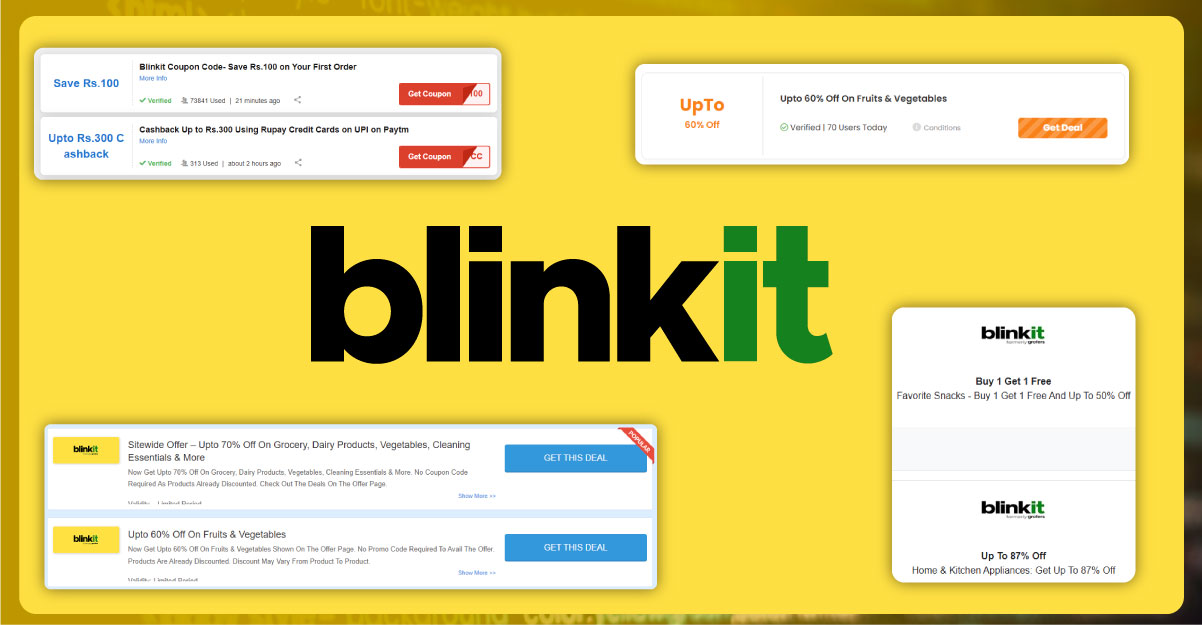
Scraping Blinkit offer details using Python provides valuable insights into discounts, promotions, and pricing strategies. By extracting and analyzing this data, businesses can stay competitive, track market trends, and make informed decisions to optimize their marketing and pricing strategies.
1. Track Discounts and Promotions:
Scraping Blinkit offer details allows businesses and developers to stay up-to-date with the latest discounts, sales, and promotional events offered by the platform. This information can be crucial for businesses looking to match or exceed Blinkit’s offers, creating a competitive advantage. By regularly monitoring offer details, businesses can align their pricing and promotional strategies with Blinkit’s, ensuring they don’t miss out on potential opportunities.
2. Market Analysis:
Extracting offer data from Blinkit provides valuable insights into the market, allowing businesses to analyze how prices and offers change over time. This data can help companies track competitor strategies, identify trends, and understand consumer demand patterns. By analyzing these offers, businesses can adjust their own pricing strategies, positioning their products more effectively to attract customers.
3. Customer Behavior Insights:
By scraping Blinkit’s offer details, businesses can gain insights into customer behavior and preferences. Understanding which products are being heavily discounted or which promotions attract the most attention can provide critical clues into consumer buying habits. This can help businesses tailor their own marketing and product strategies to meet customer needs and increase conversion rates.
4. Dynamic Price Monitoring:
Blinkit frequently updates its pricing and offer details to remain competitive in the market. By scraping these offers regularly, businesses can monitor price fluctuations in real time. This enables them to stay informed about the latest trends in the e-commerce landscape, ensuring they are always up-to-date on current prices and offers for similar products, which is crucial for dynamic pricing strategies.
5. Data-Driven Decisions:
Scraping Blinkit offer details empowers businesses to make data-driven decisions based on real-time insights. The scraped data can be used to optimize inventory management, forecast demand, and identify the most profitable products. With this information, businesses can create more targeted marketing campaigns, optimize product pricing, and improve overall operational efficiency, ensuring they stay competitive and meet customer expectations.
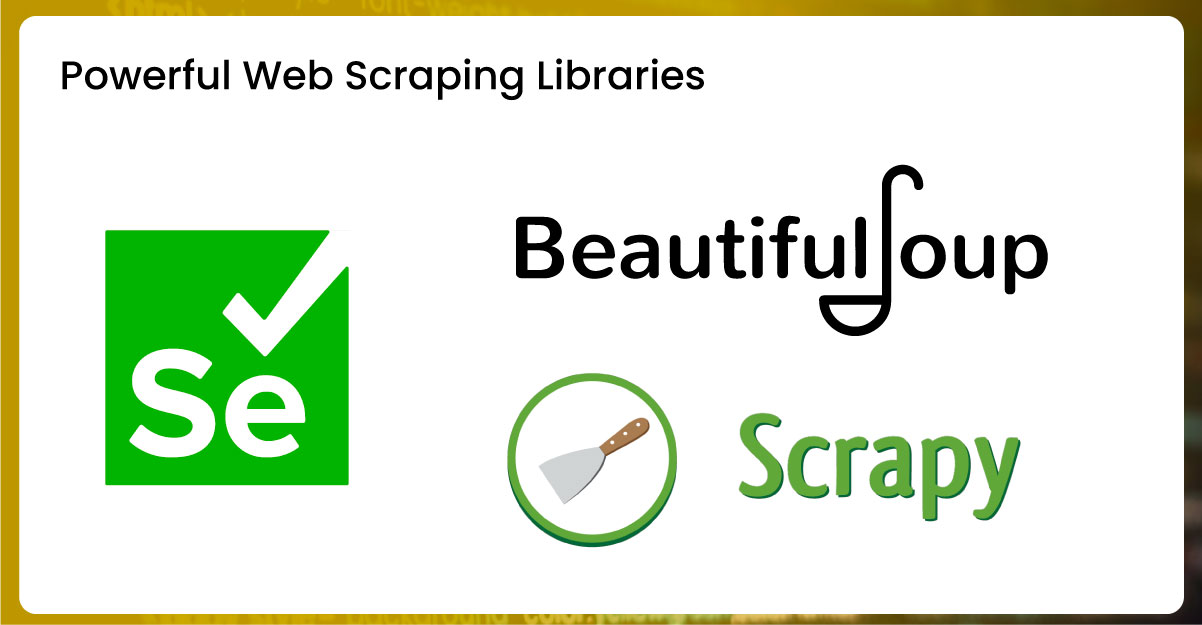
Python has gained a strong foothold in data scraping due to its simplicity, versatility, and powerful libraries. Here are some key reasons why Python is the most preferred language for scraping Blinkit data:
1. Ease of Use and Readability
Python is known for its clean and easy-to-understand syntax. Whether a beginner or an experienced developer, Python's simplicity allows you to focus on scraping logic rather than getting bogged down by complex code structures. This makes Python an ideal choice for quickly Web Scraping Blinkit Sale Data with Python, even for those with minimal programming experience.
2. Powerful Web Scraping Libraries
Python has a rich ecosystem of web scraping libraries such as BeautifulSoup, Scrapy, and Selenium, each suited for different scraping tasks. For example:
These libraries are widely used in the industry, ensuring that you can easily build efficient and reliable solutions to Scrape Blinkit Discounts and Offers Data Using Python.
3. Support for Handling Dynamic Content
Like many other modern e-commerce platforms, Blinkit uses JavaScript to load product offers and other data dynamically. While this can pose challenges for traditional scraping tools, Python's libraries like Selenium and Pyppeteer allow you to interact with dynamic content, just as a human would. These tools can simulate browser interactions, including scrolling and clicking, to scrape the data not visible in the initial HTML source. This makes Blinkit data scraping far more straightforward than static web pages.
4. Rich Data Handling and Manipulation Tools
Python excels in data manipulation, particularly with libraries like pandas and numpy. After scraping data from Blinkit, you can use these libraries to clean, organize, and analyze the data. Whether you want to store the data in a CSV file or a database or analyze it for trends, Python has the tools to handle and process data efficiently. With Web Scraping Blinkit Offers with Python, you can quickly transform raw data into actionable insights or valuable datasets like Grocery Store Datasets.
5. Extensive Documentation and Community Support
Python has a vast and active community, so developers can easily find documentation, tutorials, and forum discussions to solve any challenges they encounter while scraping Blinkit. Whether you're troubleshooting errors or seeking best practices, Python's community can support you in continuing Blinkit data scraping smoothly and efficiently.
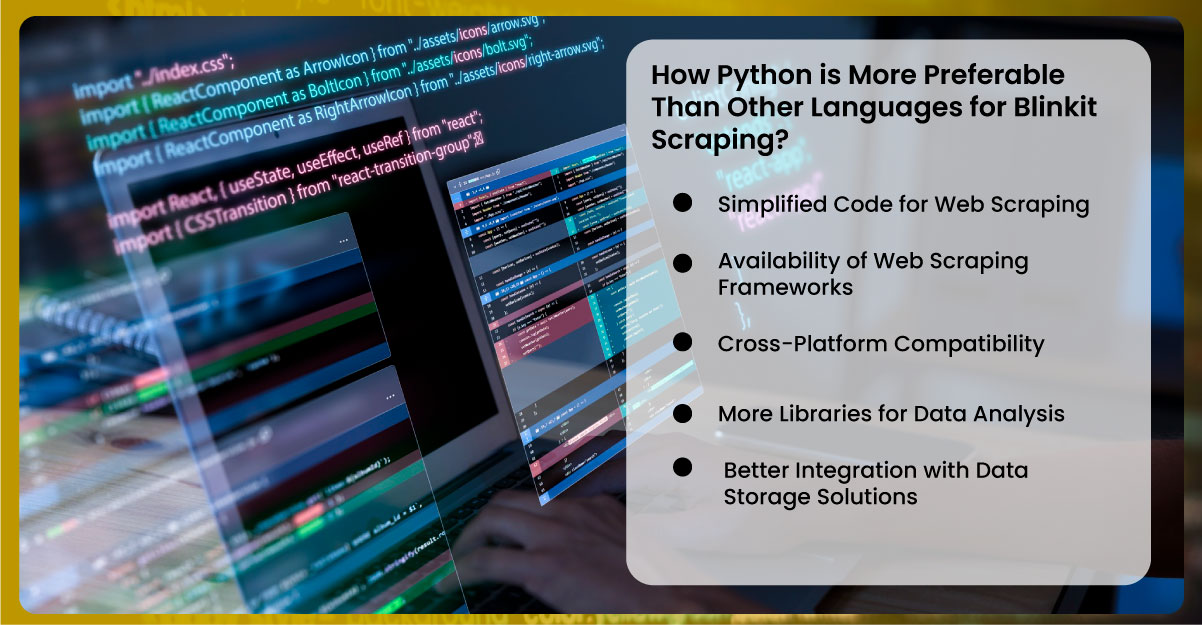
While languages like Java, Ruby, and PHP can also be used for web scraping, Python is often the clear winner. Below, we will highlight why Python is preferable over other languages for scraping Blinkit:
1. Simplified Code for Web Scraping
Languages like Java require more boilerplate code, making them harder to scrape on the web. In contrast, Python's concise syntax allows for shorter, more readable code. For example, scraping Blinkit with Python can be accomplished in just a few lines using libraries like requests and BeautifulSoup. In contrast, Java would require several setup lines to do the same.
2. Availability of Web Scraping Frameworks
While Java does have frameworks like Jsoup, it doesn't offer the same flexibility and range of options that Python provides. Python's frameworks, such as Scrapy, provide built-in tools for handling a wide range of scraping tasks, including handling redirects, retries, and even interacting with web forms or APIs.
3. Cross-Platform Compatibility
Python is a cross-platform language, meaning the same code can run on Windows, macOS, and Linux without modification. This makes Python an ideal choice for teams working in diverse environments. Other languages, like Java, may require platform-specific adjustments or dependencies.
4. More Libraries for Data Analysis
Once you have scraped the data from Blinkit, you will likely need to perform data analysis, which is where Python truly shines. Libraries like pandas, matplotlib, and seaborn make Python the go-to language for handling large datasets and generating meaningful insights. While other languages have some libraries for data analysis, Python's ecosystem is by far the most extensive.
5. Better Integration with Data Storage Solutions
Python's flexibility also extends to the range of storage options available. Whether you want to save scraped data to a local file, SQL database, or cloud storage, Python can easily integrate with different systems. Libraries like SQLite3, SQLAlchemy, and Pymongo allow seamless integration with various database systems, giving you more control over storing and processing Blinkit data.
Let's now break down the process of scraping offer details from Blinkit step by step using Python.
First, you will need to install the required Python libraries. The most common libraries for scraping Blinkit are Requests, BeautifulSoup, and Pandas. If you are working with dynamic content, you can also use Selenium.pip install requests beautifulsoup4 pandas selenium.
pip install requests beautifulsoup4 pandas seleniumStep 2: Send a Request to Blinkit
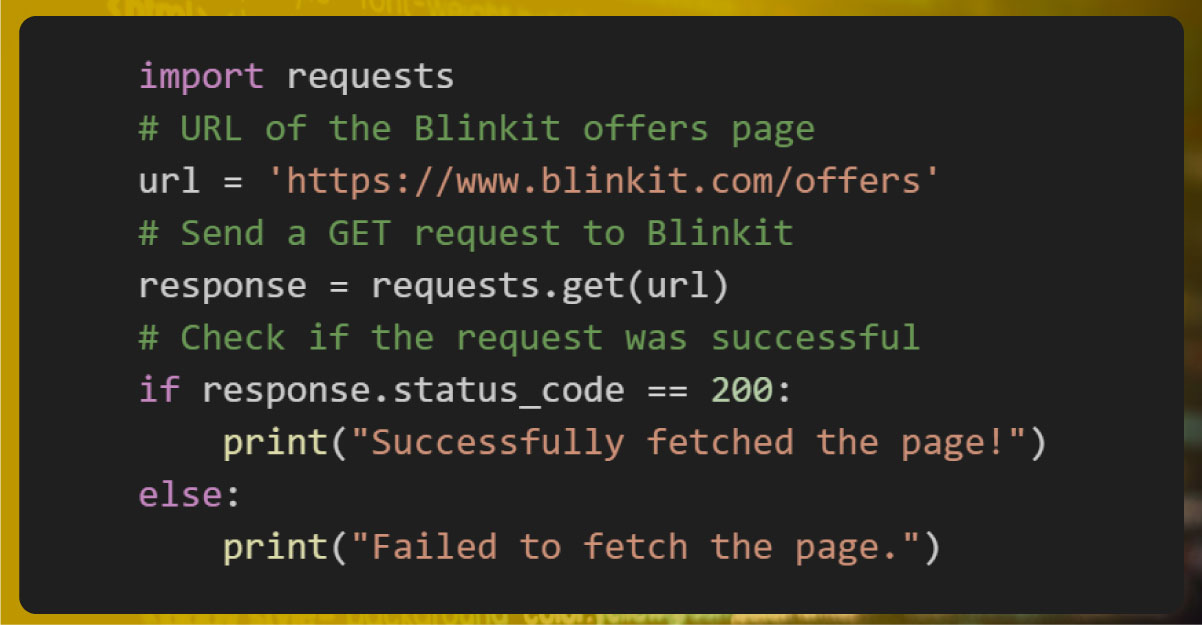
To start scraping, you must first send an HTTP request to the Blinkit website and retrieve the page's HTML content.
Step 3: Parse HTML Content with BeautifulSoup
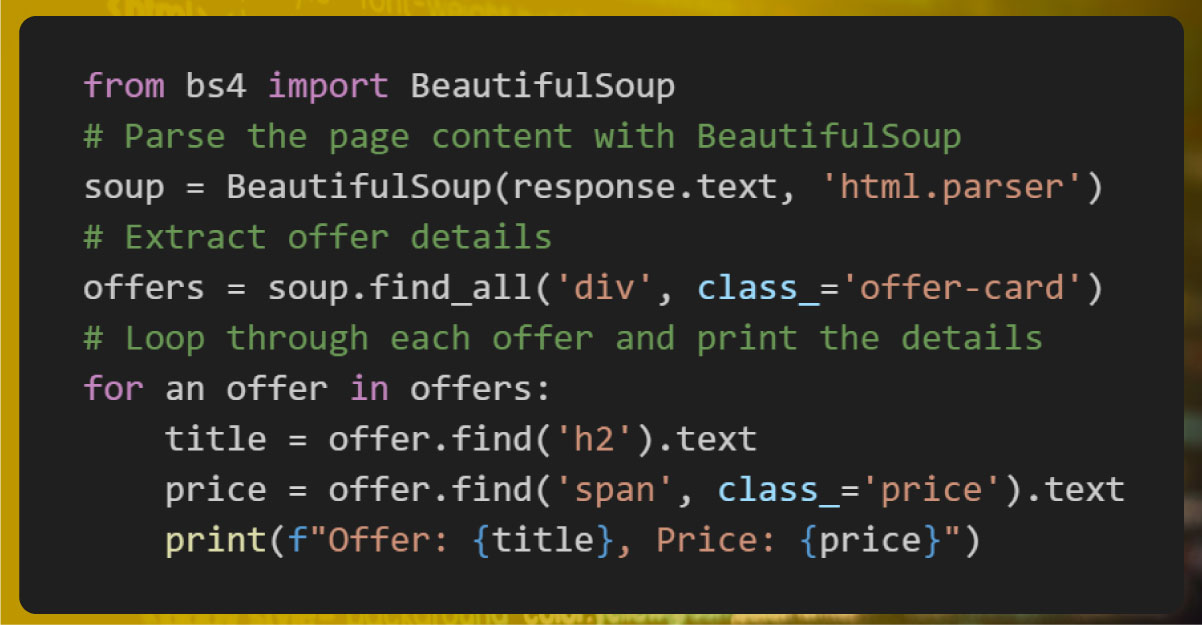
Once you have the page content, you can use BeautifulSoup to parse the HTML and extract the necessary information, such as product offers.
Step 4: Handle Dynamic Content with Selenium (Optional)
.jpg)
If the offers are dynamically loaded using JavaScript, the above approach won't work. In this case, we can use Selenium to render the page and extract the content.
Step 5: Store the Data (Optional)
.jpg)
Once you have scraped the offer details, you can store them in a structured format, such as a CSV file.
Scraping offers details from Blinkit using Python, which is a straightforward process thanks to Python's simplicity, powerful libraries, and ability to handle dynamic content. Using tools like BeautifulSoup, Scrapy, and Selenium, you can efficiently extract valuable data from Blinkit to gain insights into offers, prices, and more. Additionally, Python's robust data handling and analysis tools ensure that you can effectively store and manipulate the scraped data. Whether you're a beginner or an experienced developer, Python remains the most accessible and powerful language for web scraping tasks like Web Scraping Quick Commerce Data. With Python, you can easily collect and analyze Quick Commerce Datasets, making it the ideal choice for your Blinkit scraping needs.
Experience top-notch web scraping service and mobile app scraping solutions with iWeb Data Scraping. Our skilled team excels in extracting various data sets, including retail store locations and beyond. Connect with us today to learn how our customized services can address your unique project needs, delivering the highest efficiency and dependability for all your data requirements.